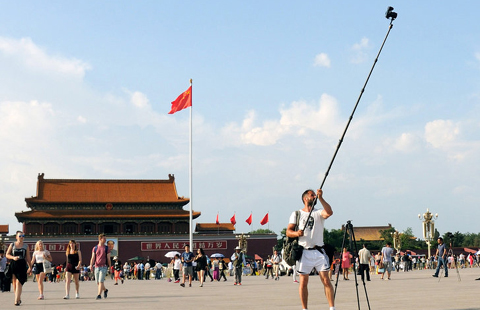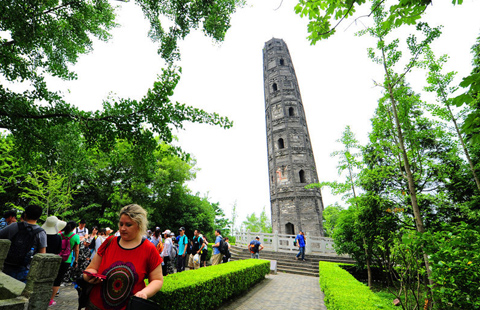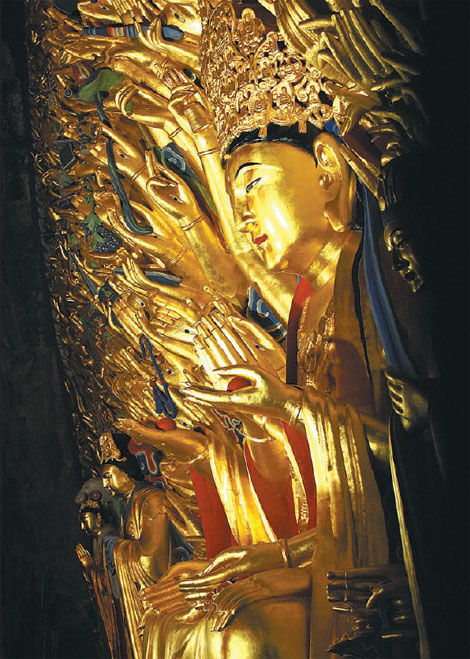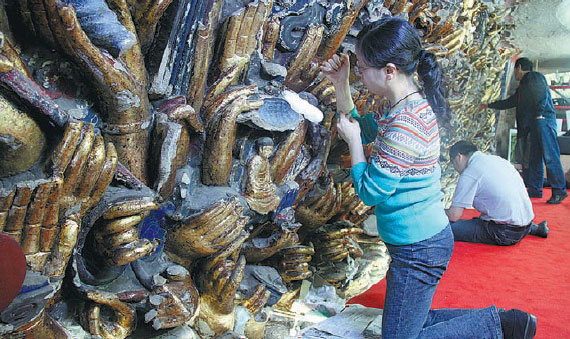Return of a goddess
Updated: 2015-06-16 07:11
By Wang Kaihao(China Daily)
|
||||||||
A community cheers as a famous 800-year-old Buddist statue among the Dazu Rock Carvings is restored and returns to public view, Wang Kaihao reports from Chongqing.
Finally, the Goddess of Mercy smiles again on pious pilgrims - with even more golden glitter than before.
After an eight-year restoration, the 800-year-old Thousand-Armed Avalokitesvara (better-known as Guanyin in Chinese, or the Goddess of Mercy), a famous Buddhist statue among the Dazu Rock Carvings in the southwestern municipality of Chongqing, was unveiled to the public on June 13, China's 10th Cultural Heritage Day.
|
The 800-year-old Thousand-Armed Goddess of Mercy at the Dazu Rock Carvings in Chongqing is unveiled to the public on June 13 after eight years of restoration. Wang Kaihao / China Daily |
|
Team members of the project undertake the restoration work. Provided to China Daily |
One day before, an elderly woman, already impatient, walked directly toward the statue and presented her tribute, while organizers were still busily rehearsing the completion ceremony.
"It is not only a cultural relic. As a religious relic, the statue has close connections with pilgrims from neighboring areas," says Zhan Changfa, chief scientist in charge of the restoration project from the Chinese Academy of Cultural Heritage. Zhan says the work posed many challenges because of the statue's size. It's 7.7 meters high and 12 meters wide.
He adds that restoration includes a complicated combination of sculptures, rock carvings and colored drawings, and there were no similarly complex examples to learn from anywhere in the world.
The Dazu Rock Carvings, which are spread over 100 locations in Chongqing's Dazu district, date back to the Tang Dynasty (AD 618-907) and peaked in the Southern Song Dynasty (1127-1279). They are generally considered to represent the world's last such comprehensive grotto artworks, and the five most representative locations were inscribed onto the UNESCO World Cultural Heritage list in 1999. Among them, the cliffside carvings complex on Baoding Mountain, including the Thousand-Armed Avalokitesvara statue, reflect the high point of Buddhism's localization in China.
Zhan explains that water seepage and weather damage are the main causes of the statue's deterioration, though modern air pollutants have accelerated its corrosion. He says 34 kinds of pathogens were detected in the statue. The team used X-ray and 3-D laser scanning to collect information and give each of 830 hands an "ID card", among which 283 were found to have been damaged.
The statue was removed from public view in 2007. It took another four years of organized appraisals until the final rescue plan was approved by the State Administration of Cultural Heritage. Other institutions joined the project, including the Dunhuang Research Academy, Tsinghua University and Peking University.
Not everyone agreed on how to go about the work. For example, traditional academics considered it important to preserve the "old look", Zhan says.
"But cultural relics are not dead," he says. "It's better to return a bright facade to this site with strong functionality. We cannot stubbornly borrow Western theories of restoration anymore."
Less than 20 percent of the original gold layers coating the statue had survived. The team decided to replace all of those with new gilded surfaces to avoid a mottled appearance, requiring about 100 kilograms of gold leaf. Zhan says this restores the statue's intended aesthetic values.
"People will only see the new faces afterwards, so it's better to soon publish a report on the restoration project based on the data collected before to give people a comparison with the old days," says Sun Hua, an archeology professor at Peking University.
There had been five major restorations since the creation of this statue, most recently in the late 19th century. Scientists have found there were flaws during the restorations in ancient times.
For example, many hands' backsides were not covered with gold leaf to save money, and some small, broken Buddha statues were not restored at all. After tense discussions, the panel finally decided to restore the original appearance, fixing previous restorers' errors.
The regular glue used in ancient sculpture restoration in northern China was not practical in hot, humid Chongqing. Zhan's team had to find local artisans who are familiar with lacquer to make paint in old ways.
"You can use new techniques on many occasions," Zhan smiles. "But you have no other choice than copying ancient ancestors in some cases."
Though Zhan says it is not easy to precisely predict how long the statue will last without major restoration in the future, he confidently predicts it will remain intact for at least 50 years.
Meanwhile, the overall project is far from the finish line. The pavilion housing the statue, built in the Ming Dynasty (1368-1644), will be restored soon. The team will also install an air-circulation system in the pavilion to minimize the toll of air and water.
"The macro environment of this statue and the whole Dazu Rock Carvings has not changed that much," says Tong Mingkang, deputy director of the State Administration of Cultural Heritage, who remains cautiously optimistic. "Therefore, supervision of this World Heritage site still needs to be enhanced to control further damage."
"When we judge the value of the Dazu Rock Carvings," says He Hong, a professor from China Academy of Art, "we have to put it into the holistic cultural context of the Southern Song Dynasty.
"But we cannot say whether it is successful. We'd better let future generations judge."
Contact the writer at wangkaihao@chinadaily.com.cn
Tan Yingzi contributed to this story.
(China Daily 06/16/2015 page18)

 Hainan San Jose to Beijing: Ready for take-off
Hainan San Jose to Beijing: Ready for take-off
 Trending Across China: A Porsche gilded in gold
Trending Across China: A Porsche gilded in gold
 Paris Air Show: From Bombardier's new C Series to China Airlines
Paris Air Show: From Bombardier's new C Series to China Airlines
 Warriors move within one win of NBA title
Warriors move within one win of NBA title
 Ten photos you don't wanna miss - weekend special
Ten photos you don't wanna miss - weekend special
 Shanghai's leaning pagoda beats the Leaning Tower of Pisa
Shanghai's leaning pagoda beats the Leaning Tower of Pisa
 Top 10 luxury houses in the world
Top 10 luxury houses in the world
 18th Shanghai Int'l Film Festival kicks off
18th Shanghai Int'l Film Festival kicks off
Most Viewed
Editor's Picks

|

|

|

|

|

|
Today's Top News
China, US to kick off key talks next week
China, US sign agreement to boost army cooperation
City honors slain NYPD
Detective Liu
Chinese students on trial in alleged torture of peer
Alibaba to launch Netflix-like video streaming service
Spacecraft that landed on comet finally wakes up
Former Chinese top legislator Qiao Shi dies in Beijing at age 91
China has adequate fiscal space to absorb local govt debt risks
US Weekly

|

|









